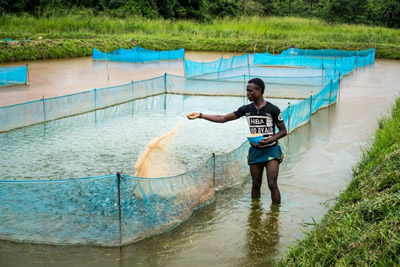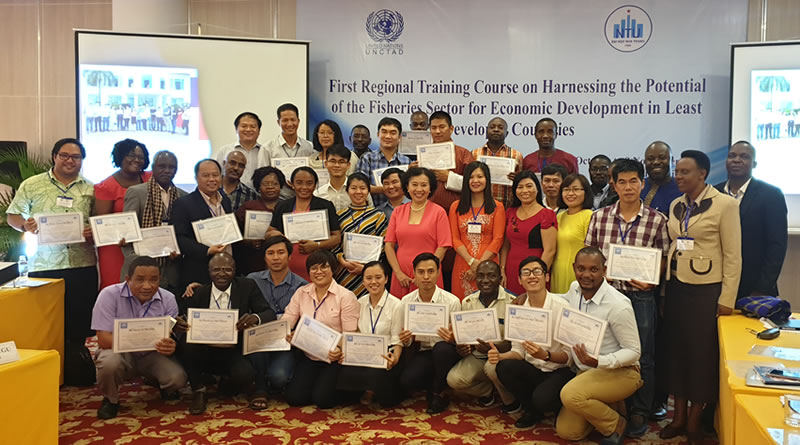Least developed countries are finding out from Viet Nam how fisheries sector opportunities can transform their economies.
“If only we could have this in our country,” says Manding Saidykhan from the Gambia in West Africa, referring to an industrial shrimp farm he visited in Viet Nam to see new aquaculture technology and fisheries management techniques.
“Our country needs this type of aquaculture, so we can have food security and reduce pressure on the seas.”
Perceptions of the potential of the fisheries sector to support some of the world’s poorest nations – the Least Developed Countries (LDCs) – are changing.
Mr. Saidykhan was among more than 50 participants of an UNCTAD-led workshop at the Regional Centre of Excellence at Nha Trang University from states as diverse as Cambodia, Comoros, Mozambique, Myanmar and Uganda.
Another participant, Paul Omani, who is the regulatory head of inspection services at Uganda’s agriculture ministry, says Viet Nam’s success as a leading exporter of high-value fish products is an inspiration to LDCs.
“We have learned about the high production systems from Viet Nam and their export-orientated focus on high-value fish species,” he says.
“We saw their production systems, highly intensive, for shrimp. This is one of the main fish species being exported to the market. It is making a very big contribution to Viet Nam’s economic development.”
Indeed, the shrimp business is one of the biggest industries in Viet Nam.
It alone contributed $3 billion to Viet Nam’s exports in 2016, a figure which could climb close to $4.8 billion in 2018.
- The path to sustainable fisheries runs through Viet Nam - Q&A with UNCTAD economist
- UNCTAD and Vietnamese university to create a sustainable fisheries training centre
“LDCs should emulate the examples and experiences of Viet Nam and put fisheries on the agenda,” Mr. Omani added.
The Viet Nam training trip has already spurred the agenda change Mr. Omani wants.
The Ugandan authorities, for instance, have expressed interest in adjusting their country’s domestic food safety standards to meet international standards and boost exports to high-end markets.
Concrete changes
The UNCTAD-led fisheries diversification training programme is having a tremendous ripple effect in other policy and regulatory circles.
Mozambique, for example, has taken important steps to develop a domestic aquaculture sub-sector.
It also established a multi-sector task force of key ministries, the private sector and civil society to develop a model for developing the marine-based and freshwater aquaculture.
Meanwhile, the government of Comoros has gone all the way, introducing a strategic piece of crucial legislation.
It penned a law requiring all vessels fishing in its sovereign waters to offload on Comorian soil, ensuring the island nation adds value to its economy, creates employment opportunities and generates more income to vulnerable sections of its society.
“We have already seen tangible impacts, with concrete changes in domestic legislation, institutions and policies in some of the participating countries,” says UNCTAD’s Mussie Delelegn, from the division for Africa, LDCs and special programmes.
“The policy and legislative changes are one development in what we anticipate will be a slew of knock-on impacts that will re-shape fisheries and aquaculture in economies that need it the most.”
Myanmar has also expressed interest and commitment to establish a national research and development center dedicated to the fisheries sector.
Shallow waters
The opportunity to use fisheries and aquaculture for export diversification is very real and important for LDCs, says UNCTAD’s Africa, LDCs and special programmes director, Paul Akiwumi.
Fish are already the most traded agricultural commodity by value.
Global production is set to increase from 187 million tonnes in 2018 to 250 million tonnes by 2030.
The sector also accounts for a large share of GDP in many LDCs – 5% in Comoros and 10% in Cambodia – and provides livelihoods for millions of workers.
Beyond diversification, the fisheries sector holds significant potential for economic and social development.
But this will only be possible if some significant hurdles – the lack of productive capacities, inadequate infrastructure, the artisanal or traditional nature of the sector, and stringent food safety and quality standards – are overcome.
LDCs face many difficulties in exporting their fishery resources.
Even though six of the top 16 producers of fish from inland waters are from developing countries, not one of the world’s 47 LDCs – categorized for structural economic and geopolitical disadvantages – features on the list of the top 10 exporters of fish products.
The share of LDCs in global fisheries exports remains at 2%, in sharp contrast with other developing countries whose export share increased from about 35% in the 1980s to more than 55% today.
Add in the pressure of keeping up with changing food quality and standards, the world’s poorest countries keep wading shallow waters.
That is why knowledge remains the key to unlocking opportunities.
Achieving the dream
Viet Nam is delivering fisheries development training to the world’s poorest countries on behalf of UNCTAD.
It hosted its first training course in October and November 2018 and 55 participants from 14 countries, including 11 LDCs, participated in the training.
“LDC’s can benefit from Viet Nam’s lessons and experiences,” says Kim Anh Nguyen, coordinator of the centre.
“Viet Nam’s fisheries sector has achieved significant growth, especially in aquaculture. We encouraged private sector investment in fish with export potential and supported the creation of vibrant institutions, such as training centres, universities and laboratories. As a result, Viet Nam has seen its fish-exports increase rapidly.”
“The dream is to help LDC’s gain in the same way.”
The centre and a similar one in Mauritius are funded by a United Nations Development Account (UNDA).
Since 2014, 500 experts, policy practitioners and officials from several LDCs and other vulnerable economies have been trained.
“Our training opens up the world of what is possible. People don’t know what they don’t know,” Mr. Delelegn says. “Training changes this.”
Training focuses on how to harness the potential of the fisheries sector for socio-economic development, improve fisheries resources management and meet food safety and quality standards.
It also helps in identify pressing challenges facing the fishery sector, and articulate policy and institutional responses to the challenges.
To date, eight workshops have been hosted, and there have been some big wins along the way. More than a quarter of the participants have been women.
China has also funded 27 participants from three project countries for intensive training and study tour opportunities to the Chinese Freshwater Fish Research Center in Wuxi, China.
“The goal of this groundbreaking UNDA project is to assist LDCs to develop their fisheries sector for export potential,” says Mr. Akiwumi.
“This will allow several LDCs to draw on their abundance of marine resources to make progress towards the Sustainable Development Goals.”
UNCTAD is preparing a fixed course curriculum including ten modules on fisheries development in partnership with the:
International Organization for Standardization (ISO)
Marine Stewardship Council (MSC)
International Maritime Organization (IMO)
Royal Tropical Institute of the Netherlands (KIT)
academic partners of Nha Trang University, Viet Nam.
Fishery Research Center of Mauritius
Environment for Development (EfD) Initiative at the University of Gothenburg
The project has two primary outputs – a policy study and a training manual, while videos of some of the participants visiting a shrimp farm can be viewed here.


